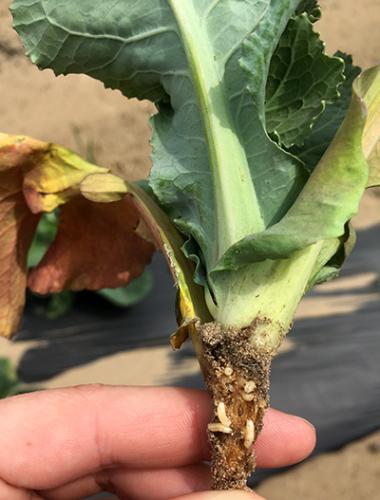Southeast Michigan vegetable update – May 24, 2017
Dry conditions have planting and field preparation rolling on with few issues.
Weather
Shifting weather patterns will bring in rain and cooler temperatures later today, May 24. Looking ahead, there is a chance of rain this weekend and early next week.
The table below presents rainfall (in inches) for the Michigan State University Enviroweather stations in southeast Michigan with the amount of change from last week reported. Degree-days (starting March 1) are calculated using the Baskerville-Emin Method. Soil temperature range (top 2 inches) over the last seven days is also included when available.
|
Rainfall and degree totals as of May 24 | ||||
|---|---|---|---|---|
|
Station |
Degree-days (base 50) |
5-year degree-day average (base 50) |
Rainfall since April 1 (inches) |
Soil temperature range |
|
309 (+60) |
328.5 |
6.01 (+1.35) |
55.5–65.8 |
|
|
415 (+84) |
Not available |
6.28 (+0.63) |
57.6–78.1 |
|
|
332 (+69) |
384.7 |
5.92 (+1.11) |
55.9–62.4 |
|
Crops
In other parts of the state, aster leafhopper is present in carrots in high numbers. This insect is of concern because it can vector the aster yellows virus, which can cause a foliage to bronze and the root to become hairy and stunted. For more information on this issue, see “Aster leafhoppers in carrots” from MSU Extension.
Cole crop planting continues. Cabbage maggot feeding has stunted some cabbage and cauliflower, though some of the stunting in cabbage can be attributed to damping off. The most developed cabbage I’ve seen will begin cupping soon.

Cabbage maggot larvae feeding on the root of cauliflower. Photo by Marissa Schuh, MSU Extension.
Watermelon and muskmelon transplants are going on out black plastic.
Pepper planting continues. The plants look healthy.
Processing tomato planting continues.
Sweet corn stands are at various growth stages. Based on degree-day accumulations, black cutworm larvae in the fields are still doing damage primarily to leaves, but this weekend the oldest larvae will reach the developmental stage where plants will be cut. For information on scouting, risk and damage thresholds, see MSU Extension’s “Pheromone catches of early-season pests cue sweet corn growers to do early-season scouting.” Trap catches have slowed dramatically for true armyworm and black cutworm this week.

A-B. Black cutworm damage by young larvae begins with feeding on all parts of the leaf. This can range from small pinholes to large holes throughout the leaf. C. Once black cutworm larvae reach the later instars, they begin cutting the plants off at the base. They will curl into a characteristic C-shape when disturbed. Photos by (A-B) Kelly Estes, Illinois Natural History Survey and (C) W.M. Hantsbarger, Bugwood.org.
I have also been in sweet corn fields with large numbers of flies bearing the appearance of small houseflies. This is likely seedcorn maggot, which based on degree-day models had its first generation emerge late last week. The flight of adults means egglaying is likely occurring—these flies are attracted to fields where the soil is freshly turned, especially those with decaying organic matter.
This pest can attack the seeds of sweet corn, beans, peas, cole crops and vine crops. Damaged bean plants often appear mangled and may have holes in the first true leaves, but in other crops damage usually manifests as stand loss. Digging in places where a plant should have emerged will often reveal a seed that has been tunneled through or hollowed out.
For a detailed overview of this pest, see MSU Extension educator Ben Werling’s “Profile of a planting-time pest: Seedcorn maggot in vegetables,” and for current product recommendations, see the “2017 Midwest Vegetable Production Guide.”
Humid weather and delays in planting will increase the likelihood of pathogens attacking transplants. Bacterial issues in tomato transplants may be seen, and botrytis is likely to appear across crops. Botrytis, also known as gray mold, causes irregular brown spotting on leaves and cankers on stems, and infection will produce powdery spores that appear as gray masses.
This disease is most likely to infect areas where dense transplants have formed a canopy of leaves and the relative humidity is high. Try to increase air circulation and reduce relative humidity either through venting or heating (when outside temperatures warrant). Preventative fungicides are available for many crops.
Contact me any time with questions at 517-264-5309 or schuhmar@msu.edu. I make updates regularly on Twitter at @SoutheastMIVeg.
Meetings
It is never too early to make accommodations to attend Great Lakes Fruit and Vegetable EXPO, Dec. 5-7, 2017, in Grand Rapids, Michigan. The combination of grower-focused, research-backed presentations and an amazing exhibit hall make it a can’t-miss event.



 Print
Print Email
Email




